Project management is the application of tools, skills, knowledge, and techniques to meet the project requirements and achieve the desired outcome. It is important as well as valuable to businesses because it helps ensure that a project delivers the expected outcomes both on time and within budget.

Table of contents
Open Table of contents
The Term
Project Management Methodology
while digging into the Project Management Methodology, it is a systematic and structured approach that outlines the processes, practices, and guidelines to be followed when planning, executing, monitoring, controlling, and closing projects.
It provides a framework for managing projects in a consistent and effective manner, helping project teams and organizations achieve their goals and deliver successful outcomes.
Phases of a PM methodology:
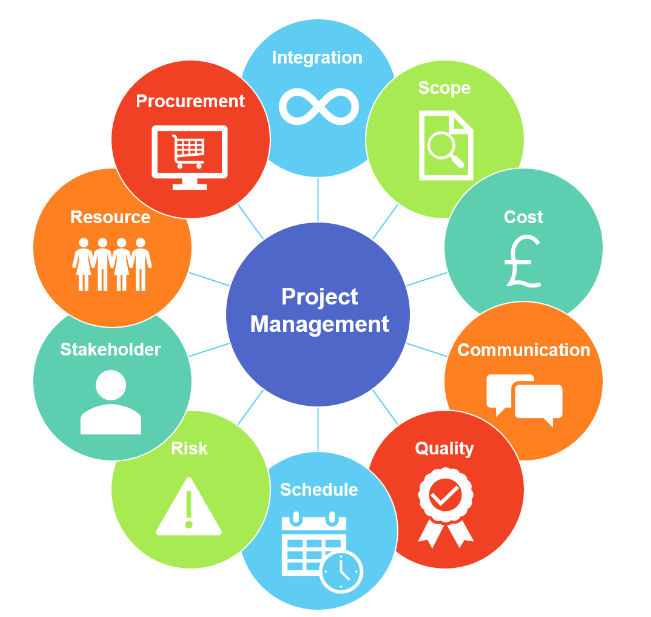
-
Project Definition : Outlining the project’s objectives, scope, deliverables,success criteria and also includes understanding the project’s purpose and aligning it with the organization’s overall goals.
-
Project Planning : A detailed plan that chalks down the activities, resources, timeline, budget, and risk management strategies of the project. This phase involves breaking down the project into manageable tasks and establishing dependencies.
-
Project Execution: Working on the tasks, resource allocating, and ensuring that the task is completed as per the schedule and quality standards.
-
Project Monitoring and Control: This phase consists of continuously tracking project progress and comparing it to the project plan, and identifying any deviations or issues. If issues are encountered then it also involves taking corrective actions to bring the project back on track.
-
Risk Management: Identifying potential risks which could impact the project’s success and developing strategies to mitigate or respond to these risks.
-
Stakeholder Management: Establishing effective communication to ensure that all the informations about the project’s status, progress are shared with the Stakeholders.
-
Quality Management: It is important to look into the project deliverables and ensure theat they are meeting the specified quality standards and also the project outcome aligns with the organization’s quality objectives.
-
Change Management: Handling changes to the project scope, requirements, or other aspects in a systematic and controlled manner.
-
Team Management: Leading and managing the project team, ensuring that team members have the necessary resources, skills, and motivation to perform their tasks effectively and efficiently.
-
Project Closure: This phase formalize the project’s completion, delivering the final product or service, obtaining client or stakeholder approval, and documenting lessons learned for future projects.
Types of PM Methodologies
- Waterfall Methodology
- Agile Methodology
- Scrum
- Kanban
- Lean
Waterfall Methodology
The Waterfall methodology is a traditional project management approach that follows a linear and sequential approach to project management. It divides the project into distinct phases :
such as
- requirements gathering
- design
- development
- testing
- deployment.
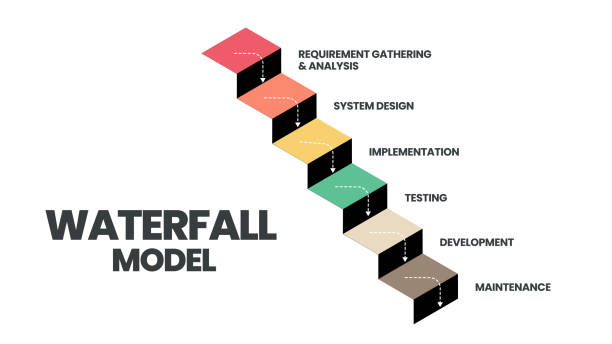
The methodology is often used for projects with well-defined requirements and stable scope, where changes are expected to be minimal.
Key advantage of the Waterfall methodology includes:
- structured approach, clear documentation, and suitability for projects with stable requirements.
Limitations of Waterfall methodology includes:
-
Limited Flexibility: does not easily accommodate changes and it can be costly and time-consuming.
-
Risks with Late findings: issues or misunderstandings may not be discovered until implementation or testing, and leading to potential rework.
-
Long Project Timelines: can lead to longer project timelines, as each phase must be completed before the next can begin.
-
Customer Involvement: customer feedback and involvement are often limited and can lead to misalignments between project outcomes and customer expectations.
Agile Methodology
The Agile methodology is an iterative and flexible approach that focuses on collaboration, adaptability, and delivering value to customers or stakeholders. It is designed to address the limitations of traditional Waterfall approaches by allowing team members to respond to changes quickly and incorporate feedback throughout the project’s lifecycle. Agile methodologies emphasize delivering working software or products in smaller, frequent iterations rather than waiting until the entire project is complete.
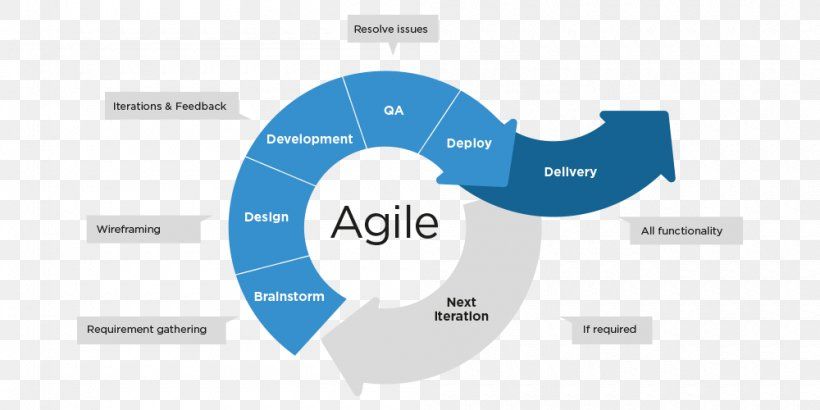
key characteristics and principles of Agile methodologies:
-
Iterative Development: In here projects are divided into short time frames called sprints, typically lasting 1 to 4 weeks and results in a potentially deliverable product that adds value to the project.
-
Customer Collaboration: Daily and close collaboration with customers, stakeholders is encouraged. Feedback received helps refine and adjust project requirements and priorities.
-
Adaptive Planning: In this case teams continuously adjust and refine the project scope, requirements, and priorities based on new information and feedback.
-
Self-Organizing: Agile teams are cross-functional and self-organizing to work on the requirements.
-
Continuous Improvement: Daily connect and improvement are integral to Agile methodologies where after each iteration, teams hold retrospective meetings to identify what worked well and what can be improved in future.
-
Delivering Value: Agile projects prioritize delivering high-value features and functionality early in the project’s lifecycle.
-
Frequent Communication: It promotes transparent and open communication within the team and with stakeholders. Daily stand-up meetings help keep everyone informed about progress and potential roadblocks or issues.
Advantages of Agile Methodology
-
Flexibility and Adaptability: can easily accommodate changes in requirements, priorities. Agile allows teams to adjust the project’s direction based on new inputs and feedback.
-
Faster Value Delivery: emphasizes delivering working increments at the end of each iteration where the stakeholders start receiving value from the project early.
-
Stakeholder Engagement: encourage regular and close sync-up with stakeholders, end-users, and customer, which leads to better alignment between project outcomes and stakeholder expectations.
-
Frequent Feedback: collect feedback throughout the project’s lifecycle to make improvements leads to a higher chance of delivering a product that meets user needs.
-
Improved Quality: continuous testing, integration, and validation, resulting in a higher-quality product.
-
Transparency and Communication: promotes open communication within the team and with stakeholders through regular meetings and progress updates.
-
Risk Mitigation: iterative approach allows to identify and address risks early in the project. Regularly assessing priorities and making adjustments reduces the impact of potential risks to happen.
-
Reduced Waste: deliver only what adds value to the project and reduces the likelihood of unnecessary work and ensures that resources are used efficiently.
Limitations of Agile Methodology
-
Scope Creep: accommodating changes can sometimes lead to scope creep, where new requirements are continuously added without proper assessment of their impact on the project’s timeline and resources.
-
Heavy Stakeholder Involvement: requires active and continuous engagement from stakeholders. If stakeholders are not fully available or do not provide timely feedback, it can hinder the project’s progress.
-
Dependency on Team Cohesion: rely on effective collaboration and communication within the team and if team dynamics are poor or a lack of cohesion is present, it can hinder the success of Agile projects.
-
Lack of Comprehensive Design Upfront: incremental approach may lead to less emphasis on comprehensive upfront design, which can be a disadvantage for projects that require a detailed and well-defined architecture.
-
Short-Term Focus: prioritize delivering value in the short term which may result in limited attention to long-term architectural projects.
Important aspects
Common Agile methodologies include:
- Scrum
- Kanban
- Extreme Programming (XP)
Scrum
Scrum is a popular Agile framework for managing complex projects, particularly in software development but also in various other industries. It focuses on collaboration, flexibility, and delivering value in short iterations called sprints. It promotes transparency, inspection, and adaptation throughout the project’s lifecycle. It provides a structured approach to project management that empowers cross-functional teams to work together efficiently and respond to changes and continuously improve its processes by adapting and accommodating changing requirements.
Benefits of Scrum
- Scrum include improved team collaboration, faster delivery, enhanced adaptability to changing customer needs, and increased transparency.
- Successful implementation of Scrum requires a dedicated Scrum Master, a supportive organizational culture, and a commitment to embracing Agile principles.
- Scrum is well-suited for projects with changing requirements where delivering is frequent and tangible outcome is essential.
Limitations of Scrum
- Scope Creep: While Scrum emphasizes flexibility, the team might struggle with frequent changes due to improper handling of changing requirements and can lead to scope creep.
- Learning Curve: Transitioning to Scrum may experience a learning curve, leading to initial challenges and potential inefficiencies.
- Lack of Clear Engineering Practices: Scrum doesn’t provide specific guidance on engineering practices like coding standards, design principles, and architectural considerations.
Kanban
Kanban is an Agile project management and work visualization method that emphasizes visualizing work, limiting work in progress, and optimizing workflow efficiency. Kanban has been adapted for various industries, including software development, project management, and other knowledge work environments. Kanban boards display tasks and their statuses, helping teams manage workflow and optimize efficiency. It’s suitable for projects with varying priorities and frequent changes, and it’s often used in scenarios where traditional planning cycles might not be as effective.
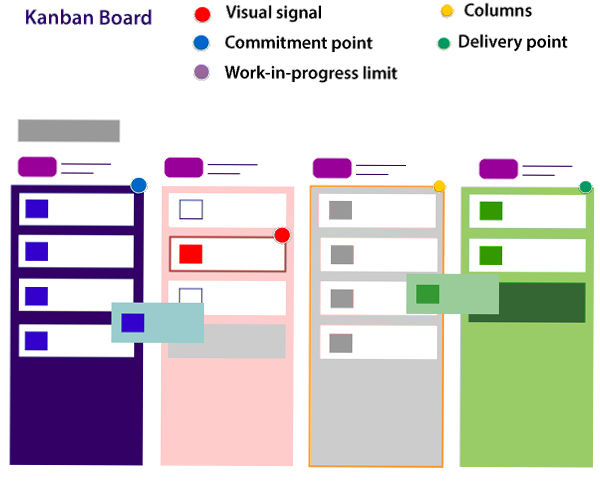
Core principles of Kanban include:
Visualizing Work: Kanban uses a visual board (Kanban board) to represent the workflow of tasks or items that moves through different stages on the board, making it easy to see the status of work at a glance.
Limiting Work in Progress (WIP): Kanban focuses on preventing overloading of the team by setting limits on the number of tasks that can be in progress at any given time.
Managing Flow: The goal of Kanban is to achieve a smooth and efficient flow of work through the various stages of the process. By identifying bottlenecks and areas of inefficiency, teams can make targeted improvements.
Continuous Improvement: Kanban encourages teams to regularly analyze their processes, identify areas for improvement, and implement changes to enhance efficiency and effectiveness.
Limitations of Kanban
- Lack of Structured Planning: Without clear milestones or predefined timelines, Kanban can sometimes lead to a lack of structured planning.
- Limited Process Improvement: It may not provide as structured a framework as other methodologies for identifying and addressing deeper process issues.
- Lack of Timeboxing: Kanban doesn’t have fixed timeboxes or iterations like Scrum does and can make it challenging to estimate delivery timeline or manage expectations for stakeholders.
Extreme Programming (XP)
Extreme Programming (XP) is an Agile software development methodology that emphasizes collaboration, customer satisfaction, and producing high-quality software. It’s particularly suited for projects where customer feedback is essential, and where the team values practices that emphasize collaboration, simplicity, and iterative improvement.This aims to deliver value quickly while maintaining a focus on software quality and customer needs.
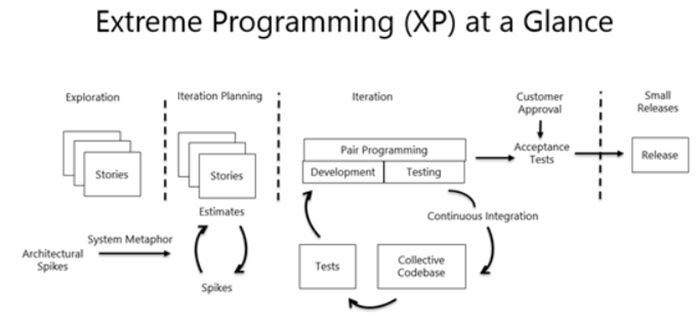
Key practices and values of Extreme Programming include:
Values:
-
XP encourages open and transparent communication among team members, stakeholders, and customers which ensures that everyone is on the same page and understands the project’s goals.
-
Promotes keeping the design and code as simple as possible and reduces complexity and maintain the software.
-
Frequent feedback loops are integral to XP for continuously improvement the product.
-
Encourages teams to take calculated risks and address challenges.
-
Collaboration and a positive team dynamic are fostered through mutual respect.
Practices:
-
Test-Driven Development (TDD): Developers write automated tests before writing the actual code which ensures that the code meets the expected functionality and helps maintain code quality over time.
-
Pair Programming: Two programmers work together at the same time, with one writing the code while the other reviews and provides immediate feedback. This practice promotes knowledge sharing, quality, and collaboration.
-
Continuous Integration: Code changes are frequently integrated into a shared repository, and automated tests are run to catch integration issues.
-
Collective Code Ownership: Team members are responsible for the codebase, promoting shared accountability and collaboration.
Final Takeway
- To close a project and achieve specific goals, we choose Project management. which provides the discipline of planning, organize, execute, control.
- It involves applying knowledge, skills, tools, and techniques to ensure that a project is completed successfully.
- Effective project management helps organizations achieve their objectives by ensuring that projects are completed on time, within budget, and to the desired quality standards.
